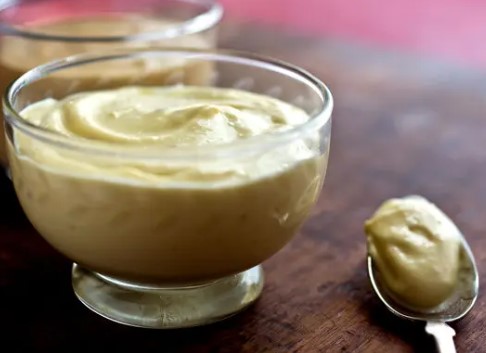Aioli and rouille, derived from the Spanish words meaning “garlic-oil,” are emblematic of the Mediterranean culinary tradition. These flavorful condiments showcase the harmonious marriage of garlic, olive oil, and other complementary ingredients. The fundamental aioli is born from the simple act of grinding garlic and salt into a paste, then transforming it into a velvety sauce with the addition of olive oil and lemon. For a richer consistency, I often incorporate egg yolk as a base. Ancient wisdom guides the tradition of thickening aioli with bread, creating a sauce that adds body to soups and dishes. Rouille, a vibrant variant, introduces the allure of red bell peppers to the mix, resulting in a deep red rust hue. Made efficiently using a mortar and pestle, these sauces become not only culinary masterpieces but also a communal experience as the mortar takes center stage on the table. Both aioli and rouille elevate seafood, meats, vegetables, and soups, infusing each dish with Mediterranean flair and an unmistakable burst of flavor. So, let’s embark on a journey to create these iconic condiments that have graced tables across generations.
INGREDIENTS:
- AIOLI:
- 1 clove garlic, roughly chopped
- Grated zest and juice of 1 lemon
- 1/4 teaspoon salt
- 1 egg yolk
- 1 cup olive oil
- 1 slice day-old Basic Country Bread (page 45)
- ROUILLE:
- 1 red bell pepper, peeled, roasted, and seeded
- 1/2 teaspoon red pepper flakes
- 1 recipe Aioli
PREPARATIONS:
- To make aioli, combine garlic, lemon zest, and salt in a mortar. Pound with a pestle to create a paste.
- Add egg yolk and 1/2 teaspoon of lemon juice to the mortar. Stir vigorously with the pestle while gradually adding olive oil, drop by drop.
- Once half of the oil is incorporated, the sauce should be creamy and smooth, indicating a stable emulsion.
- Continue stirring and slowly stream in the remaining oil to achieve desired thickness.
- Use additional lemon juice to flavor or thin the aioli if needed. Transfer aioli to a bowl.
- Place the bread in the mortar with a spoonful of lemon juice or water. Pound with the pestle to create a smooth paste.
- Add aioli to the bread paste in the mortar. Stir to combine, then transfer back to the bowl for serving.
ROUILLE:
- In the mortar, combine roasted red pepper and red pepper flakes. Pound with the pestle to create a paste.
- Stir the pepper paste into the aioli until smooth. Serve.
YIELD:
- Makes approximately 1 cup of aioli.
SPECIAL INSTRUCTIONS:
- Utilize a mortar and pestle for optimal efficiency and flavor.
- Incorporate olive oil gradually for a stable aioli emulsion.
- Adjust the consistency of aioli with lemon juice as needed.
TIPS:
- Serve aioli and rouille as versatile accompaniments to seafood, meats, vegetables, and soups.
- Experiment with the level of red pepper flakes in rouille to achieve desired spice level.
- Freshly prepared aioli and rouille offer the best flavor, but they can be stored in the refrigerator for a short period.
In essence, aioli and rouille epitomize the timeless magic of Mediterranean cuisine, encapsulating the region’s love affair with bold flavors and simple, natural ingredients. From the humble union of garlic and olive oil, aioli emerges as a luscious and creamy condiment that’s not only versatile but also a testament to culinary craftsmanship. The egg yolk fortifies the emulsion, while the incorporation of bread creates a stable texture perfect for enhancing soups and dishes.
Rouille, a vibrant kin of aioli, showcases the culinary prowess of infusing red bell peppers and red pepper flakes into the mix. The resulting hue reflects the rich depth of flavors within, adding a visual feast to the taste experience. With both aioli and rouille, the mortar and pestle emerge as the alchemists’ tools, transforming ingredients into sauces that stand as cornerstones of Mediterranean gastronomy.
These condiments are more than just accompaniments; they are a window into the past and a reflection of the present. The act of preparing aioli and rouille invites us to slow down, engage with the ingredients, and connect with traditions that have been handed down through generations. The mortar and pestle, placed on the table for communal use, foster a sense of togetherness and shared appreciation for the culinary arts.
As we savor the robust flavors of aioli and rouille, we also savor the wisdom of ages gone by—when ingredients were treasured and transformed into delightful feasts. The versatility of these sauces is awe-inspiring, turning humble dishes into memorable culinary experiences. Whether adorning freshly grilled seafood, adding depth to vegetable medleys, or enhancing the heartiness of soups, aioli and rouille are culinary companions that bring warmth and flavor to every bite.
Aioli and rouille are not merely sauces; they are the embodiment of a culinary philosophy that values simplicity, creativity, and the harmonious interplay of flavors. These sauces, born from the union of humble ingredients, remind us that the most beautiful and delicious things in life often arise from the simplest origins. So, as we indulge in the exquisite embrace of aioli and rouille, we celebrate the art of transformation and honor the spirit of Mediterranean cooking.


